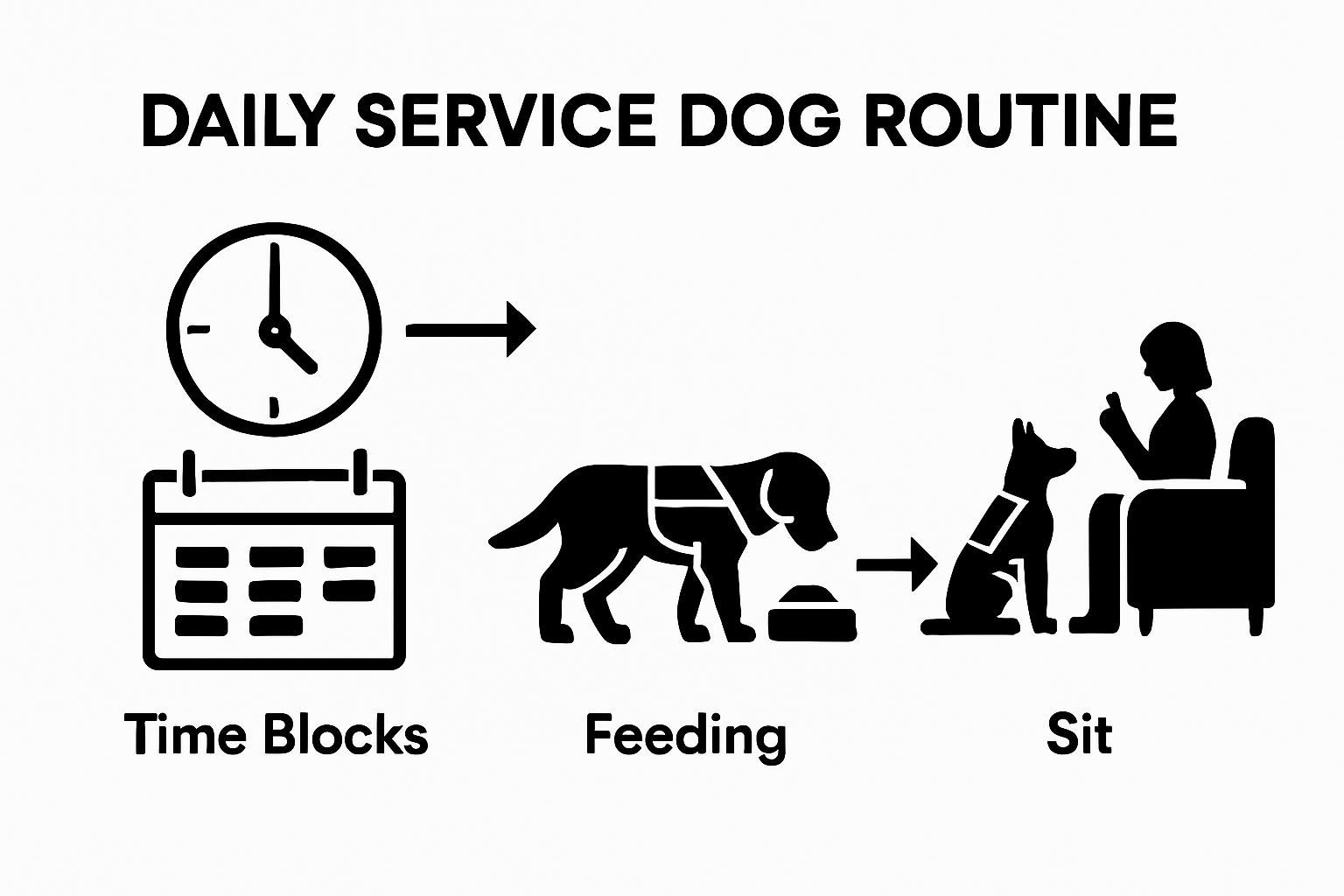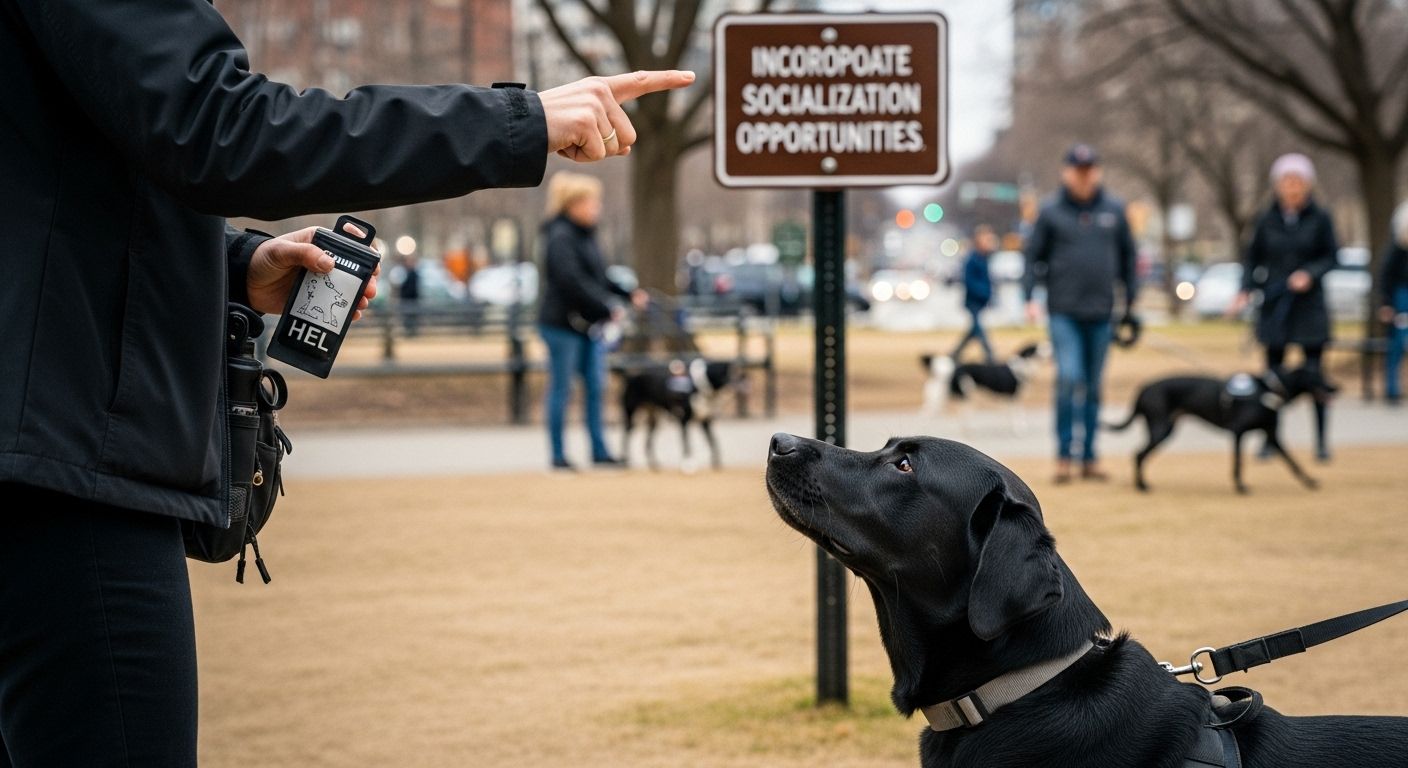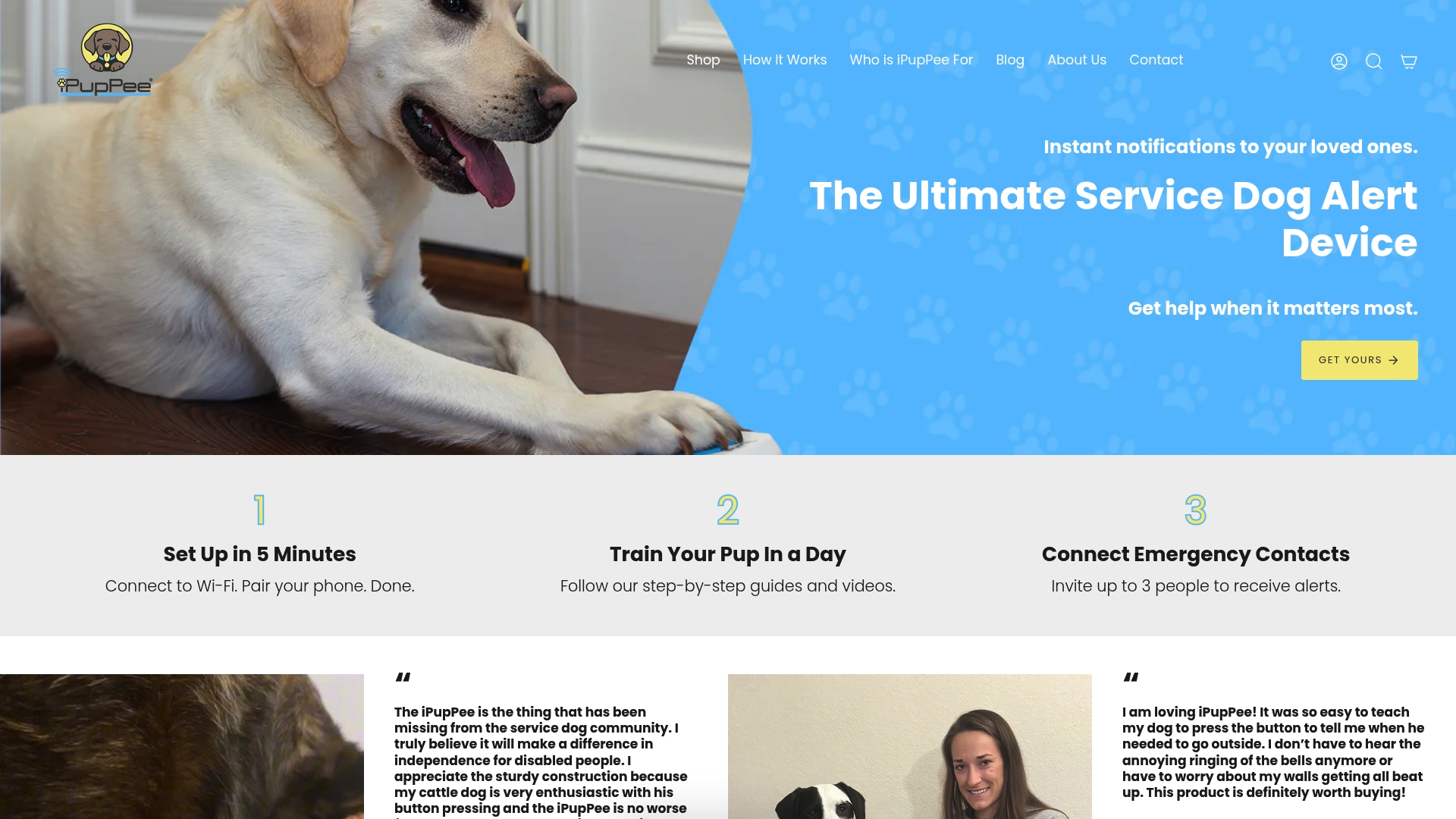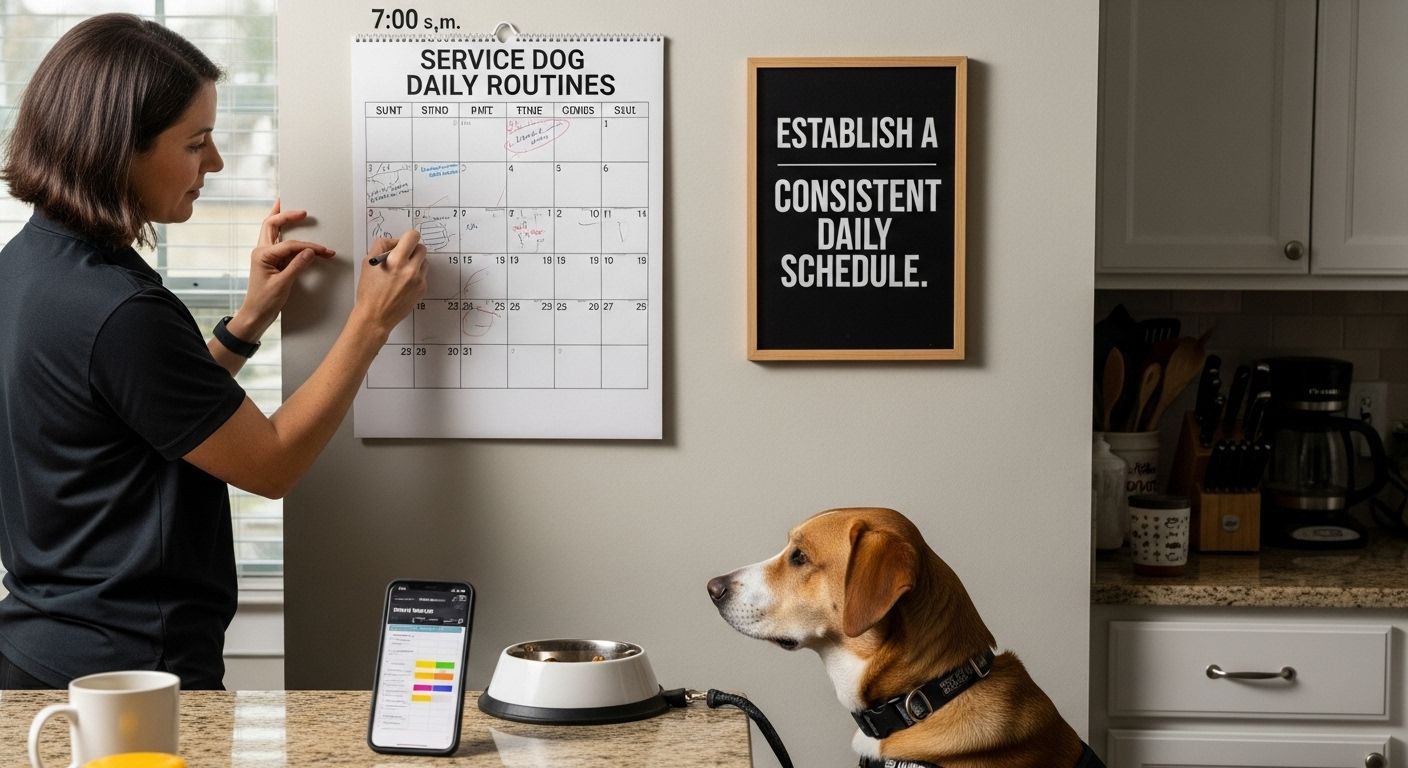Training a service dog is more than just teaching a handful of tricks. The journey takes patience, structure, and a bit of science. Get this. A solid daily routine can boost your service dog’s focus and reduce anxiety by up to 50 percent. Most people think success comes from endless drills or sheer natural talent. The real breakthrough comes from building small, steady habits that transform your dog into a confident, reliable partner.
Table of Contents
- Step 1: Establish A Consistent Daily Schedule
- Step 2: Implement Basic Training Commands
- Step 3: Incorporate Socialization Opportunities
- Step 4: Monitor Health And Fitness Activities
- Step 5: Reinforce Positive Behavior And Skills
- Step 6: Evaluate And Adjust Routines For Growth
Quick Summary
| Key Point | Explanation |
|---|---|
| 1. Establish a consistent routine | Maintain a daily schedule for your service dog to ensure structure and predictability, helping reduce anxiety and foster reliability. |
| 2. Implement basic training commands | Focus on foundational commands like sit and stay, using consistent verbal and non-verbal cues for clear communication and responsiveness. |
| 3. Incorporate socialization opportunities | Gradually expose your service dog to various environments and scenarios to build confidence and adaptability in real-world situations. |
| 4. Monitor health and fitness | Regularly assess your service dog’s physical fitness and health through structured exercise and veterinary care to maintain their performance. |
| 5. Reinforce positive behavior consistently | Use varied rewards, including treats and praise, to encourage desired behaviors and strengthen the bond with your service dog. |
Step 1: Establish a Consistent Daily Schedule
Establishing a consistent daily schedule is the foundational blueprint for successful service dog training and performance. Just like humans, service dogs thrive on predictability and structured routines that provide clear expectations and reduce anxiety. A well-designed daily schedule transforms your service dog from a simple companion into a reliable, confident partner who understands precisely what is expected.
Begin by mapping out a schedule that mirrors your typical day, incorporating essential activities like feeding, bathroom breaks, training sessions, exercise, and rest periods. Your routine should be realistic and sustainable, accounting for both your dog’s physical needs and your personal lifestyle. Consistency is key - aim to perform each activity at approximately the same time and in the same sequence every day.
Start by creating a visual schedule you can follow. Consider using a large wall calendar or digital tracking app to record your service dog’s daily activities. Schedule morning bathroom breaks immediately after waking, followed by a nutritious meal and brief training session. Space out activities to prevent overwhelming your dog and ensure adequate rest between more demanding tasks. Your morning routine might include a 15-20 minute walk, followed by focused skill practice, then a period of calm relaxation.

Make adjustments as needed, but maintain the core structure. Some days will require flexibility, but try to keep core timing and sequence consistent. Watch your dog’s response and energy levels, and be prepared to make subtle modifications that support their overall well-being. Learn more about training consistency to refine your approach and create a seamless partnership.
Verify your schedule’s effectiveness by monitoring your service dog’s behavior, stress levels, and task performance. A well-structured routine will result in a calmer, more confident dog who anticipates and executes tasks with precision and enthusiasm.
Here is a summary table outlining each major step in mastering a service dog’s daily routine, including its main focus and what to verify for success.
| Step | Main Focus | What to Verify for Success |
|---|---|---|
| Establish a Consistent Daily Schedule | Predictable structure and timing | Calmer behavior, anticipates tasks, reduced anxiety |
| Implement Basic Training Commands | Teaching foundational commands | Consistent, immediate responses across environments |
| Incorporate Socialization Opportunities | Gradual exposure to varied settings | Calm, confident reactions to new experiences |
| Monitor Health and Fitness Activities | Regular exercise and wellness checks | Ideal weight, enthusiasm for work, recovery time |
| Reinforce Positive Behavior and Skills | Varied, timely rewards for good actions | Enthusiastic performance, strong handler bond |
| Evaluate and Adjust Routines for Growth | Ongoing assessment and routine tweaks | Sustained motivation, adapting skills, cooperation |
| Remember that building this routine takes time and patience - celebrate small victories and remain committed to your training process. |
Step 2: Implement Basic Training Commands
Basic training commands form the critical communication foundation between you and your service dog, transforming a simple companion into a precise, responsive partner. These fundamental commands establish clear expectations, build mutual understanding, and create a framework for more advanced service tasks. Mastering these core instructions is essential for developing a reliable working relationship that enhances independence and safety.
Start with foundational commands like sit, stay, come, heel, and down. Begin each training session in a quiet environment with minimal distractions, using high-value treats as positive reinforcement. Consistency is paramount your tone, hand signals, and verbal commands should remain identical during every practice. Practice each command in short 5-10 minute sessions, multiple times daily, gradually increasing complexity and introducing distractions as your dog demonstrates proficiency.
Pay special attention to your body language and vocal cues. Dogs are incredibly perceptive to non-verbal communication, so maintain a calm, confident demeanor during training.
Use clear, concise verbal commands paired with consistent hand signals. For instance, when teaching “sit,” say the word firmly while simultaneously moving your hand from an extended position to above the dog’s head, which naturally encourages them to lower their hindquarters. Explore our comprehensive guide on teaching basic commands to refine your techniques and understand nuanced training approaches.
Verify your training progress by testing commands in progressively challenging environments. A successfully trained service dog should respond consistently whether at home, in a busy grocery store, or during unexpected social interactions. Look for immediate, precise responses without hesitation. Remember that every dog learns differently some may require more repetition or alternative teaching methods. Patience, positive reinforcement, and unwavering consistency will transform these basic commands into a seamless communication system that empowers both you and your service dog.
Step 3: Incorporate Socialization Opportunities
Socialization is the critical process of exposing your service dog to diverse environments, people, sounds, and experiences that build confidence and adaptability. Effective socialization transforms a nervous puppy into a calm, reliable working partner capable of navigating complex real-world scenarios with composure and focus. This step goes beyond simple exposure it requires strategic, controlled interactions that help your dog develop positive associations and emotional resilience.
Begin socialization gradually, starting in controlled environments and progressively introducing more complex scenarios. Take your service dog to different locations like shopping centers, public parks, quiet cafes, and public transportation hubs. Each outing should be short, positive, and structured. Watch your dog’s body language carefully, rewarding calm behavior and providing gentle reassurance during potentially stressful encounters. Use high-value treats and maintain a relaxed demeanor to help your dog understand that new experiences are safe and enjoyable.
Focus on exposing your service dog to a wide range of stimuli without overwhelming them. This includes different surface textures, varying noise levels, unfamiliar people, other animals, and unexpected movements. Practice walking through crowded areas, encountering wheelchairs, navigating elevators, and remaining calm during sudden loud noises. Discover expert tips on comprehensive dog socialization to refine your approach and understand nuanced training techniques. The goal is creating a service dog who remains focused and unflappable in any environment, treating unusual circumstances as routine rather than threatening.
Verify successful socialization by observing your dog’s reactions in progressively challenging situations. A well-socialized service dog should demonstrate consistent composure, quick recovery from unexpected stimuli, and an ability to maintain focus on their handler. Look for signs of confidence like relaxed body language, controlled breathing, and immediate responsiveness to commands, even when surrounded by distractions.
 Remember that socialization is an ongoing process requiring patience, positive reinforcement, and a commitment to gradually expanding your dog’s comfort zone.
Remember that socialization is an ongoing process requiring patience, positive reinforcement, and a commitment to gradually expanding your dog’s comfort zone.
Step 4: Monitor Health and Fitness Activities
Monitoring your service dog’s health and fitness is a critical component of maintaining their performance, longevity, and overall well-being. A proactive approach to health management ensures your service dog remains capable, comfortable, and ready to perform essential tasks. This step involves creating a comprehensive wellness strategy that addresses physical fitness, nutrition, veterinary care, and early detection of potential health issues.
Establish a consistent fitness routine tailored to your service dog’s specific needs and working requirements. Daily exercise should include a combination of structured activities like walking, light jogging, strength training, and mental stimulation exercises. Pay attention to your dog’s energy levels, muscle tone, and overall body condition. Incorporate activities that mirror their service tasks, such as practice walks with weighted vests or obstacle navigation, to maintain functional fitness. Aim for 30-45 minutes of active movement daily, breaking sessions into shorter intervals to prevent overexertion.
Regular veterinary check-ups are non-negotiable for service dogs. Schedule comprehensive annual examinations that include full physical assessments, blood work, dental evaluations, and preventative screenings. Learn more about maintaining your service dog’s optimal health to understand the nuanced aspects of preventative care. Consider investing in activity tracking devices that monitor heart rate, respiratory patterns, and daily movement. These technological tools can provide early warning signs of potential health issues, allowing for prompt intervention and preventing minor concerns from developing into more serious conditions.
Verify your health monitoring success by maintaining detailed health logs. Track weight, activity levels, nutrition, medical visits, and any observed changes in behavior or performance. A well-maintained service dog should demonstrate consistent energy, maintain ideal body weight, exhibit strong muscle tone, and show enthusiasm for work.
Use this checklist to verify your service dog’s health and fitness are on track as described in the guide.
| Action Item | How to Check | Frequency |
|---|---|---|
| Weight Tracking | Record and monitor changes in body weight | Weekly |
| Activity Levels | Observe energy, playfulness, task readiness | Daily |
| Nutrition Assessment | Ensure balanced meals, monitor eating habits | Daily |
| Veterinary Visits | Schedule and attend full health exams | Annually |
| Medical Logs | Document meds, check-ups, any issues | Ongoing |
| Behavior Changes | Watch for stress, low energy, other shifts | Weekly |
| Signs of successful health management include quick recovery after tasks, stable eating and sleeping patterns, and minimal stress-related behaviors. Remember that each dog is unique biological needs and fitness requirements can vary, so remain flexible and attentive to your individual service dog’s specific health signals. |
Step 5: Reinforce Positive Behavior and Skills
Positive reinforcement is the cornerstone of developing a reliable, confident, and motivated service dog. This critical step transforms basic training into a dynamic, responsive partnership by creating a reward system that encourages desired behaviors and strengthens the communication bond between handler and dog. The goal is to make good behavior more appealing than alternative actions, building a foundation of trust and mutual understanding.
Design a nuanced reinforcement strategy that goes beyond simple treat rewards. Vary your positive reinforcement techniques to include verbal praise, physical affection, play, and special attention. Use high-value treats during initial training, then gradually transition to intermittent rewards that maintain excitement and engagement. Timing is crucial deliver rewards immediately after the desired behavior to create a clear connection between the action and the positive outcome. For service dogs, this means rewarding not just completed tasks, but also moments of focus, calm behavior, and quick responsiveness in challenging environments.
Consistency becomes your most powerful training tool. Every interaction is an opportunity to reinforce good behavior, whether you’re practicing formal commands or navigating daily life. Explore advanced techniques for behavioral reinforcement to refine your approach and understand the nuanced psychology of dog training. Pay close attention to your dog’s individual motivations some may respond better to play, while others are more food-motivated. Develop a personalized reinforcement approach that considers your service dog’s unique personality, working requirements, and individual learning style.
Verify the effectiveness of your reinforcement strategy by observing your service dog’s overall performance and attitude. A successfully reinforced dog will demonstrate enthusiastic task completion, consistent focus, and a genuine desire to work alongside you. Look for signs of confidence, such as alert body language, quick response times, and a relaxed demeanor in challenging situations. Remember that positive reinforcement is an ongoing process that requires patience, creativity, and a deep understanding of your service dog’s individual needs and motivations.
Step 6: Evaluate and Adjust Routines for Growth
Evaluating and adjusting service dog routines is a dynamic process that ensures continuous improvement and maintains the highest level of performance. Successful service dog partnerships are built on flexibility and responsive adaptation, recognizing that both the dog and handler evolve over time. This step transforms your routine from a static plan into a living, breathing strategy that grows with your unique relationship and changing needs.
Establish a systematic approach to routine evaluation by creating detailed documentation of your service dog’s daily performance, behavioral patterns, and task execution. Use a combination of written logs, video recordings, and periodic professional assessments to capture comprehensive insights. Track metrics like task completion rate, response time, stress indicators, and overall energy levels. Pay close attention to subtle changes in your dog’s behavior, motivation, and physical condition. These nuanced observations will provide critical information about when and how to modify your existing routine. Some adjustments might involve tweaking training methods, adjusting exercise intensity, or introducing new mental stimulation techniques to prevent burnout and maintain engagement.
Discover strategies for maintaining consistent training progress to help refine your approach to routine management. Consult with professional trainers, veterinarians, and service dog specialists at least twice annually to conduct comprehensive evaluations. These expert insights can help identify potential areas of improvement that might not be immediately apparent. Be prepared to make incremental changes rather than dramatic overhauls, allowing your service dog to adapt gradually and comfortably to new expectations.
Verify the success of your evaluation and adjustment process by observing your service dog’s overall performance, emotional well-being, and enthusiasm for work. A well-adjusted routine produces a confident, responsive partner who demonstrates consistent skills, maintains physical and mental health, and continues to grow in their capabilities. Look for signs of sustained motivation, quick skill acquisition, and a strong, trusting bond that reflects the collaborative nature of your service dog partnership. Remember that growth is a continuous journey requiring patience, observation, and a genuine commitment to understanding your dog’s unique needs.
Transform Your Service Dog’s Daily Routine With Real Results
Every service dog handler wants more confidence and cooperation in daily routines, but building that structure can be exhausting and overwhelming. The article you just read highlighted real pain points: keeping tasks consistent, promoting independent communication, and reinforcing positive behaviors for maximum reliability. Many struggle to ensure their service dog’s needs are met while maintaining personal safety and independence—especially if you live alone or care for someone with special needs.

Imagine a smarter way to communicate and reinforce your routine. The iPupPee alert device bridges the gap between structure and freedom, empowering your service dog to signal needs independently with a simple button press. This unique solution encourages routine mastery, supports positive behavior, and enhances daily safety through seamless communication. Ready to support your training goals with proven technology and expert guidance? Visit iPupPee’s homepage to explore powerful testimonials, in-depth product info, and real tips from successful handlers. For more insights, see our blog on dog training consistency and unlock new levels of independence for you and your dog. Take the next step now—help your service dog become their best partner with the tools and support trusted by pros.
Frequently Asked Questions
How can I create a consistent daily schedule for my service dog?
To establish a consistent daily schedule for your service dog, map out your typical day, incorporating essential activities like feeding, bathroom breaks, training sessions, exercise, and rest periods. Aim to perform each activity at approximately the same time and in the same sequence every day to help your dog understand expectations.
What basic commands should I teach my service dog first?
Start with foundational commands such as sit, stay, come, heel, and down. These commands are essential for establishing clear communication and expectations between you and your service dog, forming the basis of their training.
How important is socialization for a service dog?
Socialization is critical for a service dog as it helps them become confident and adaptable in diverse environments. Gradually expose your dog to various people, sounds, and experiences to build their resilience and ability to navigate complex situations calmly.
What strategies should I use to reinforce positive behavior in my service dog?
Utilize a mix of rewards for positive reinforcement, including high-value treats, verbal praise, physical affection, and play. Consistency in your reinforcement techniques is key to encouraging desired behaviors and strengthening the bond between you and your service dog.

